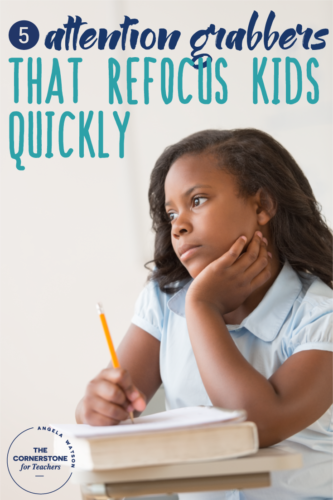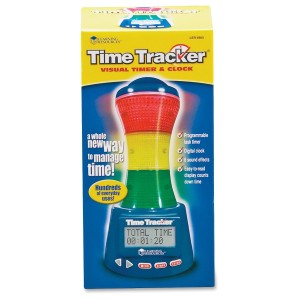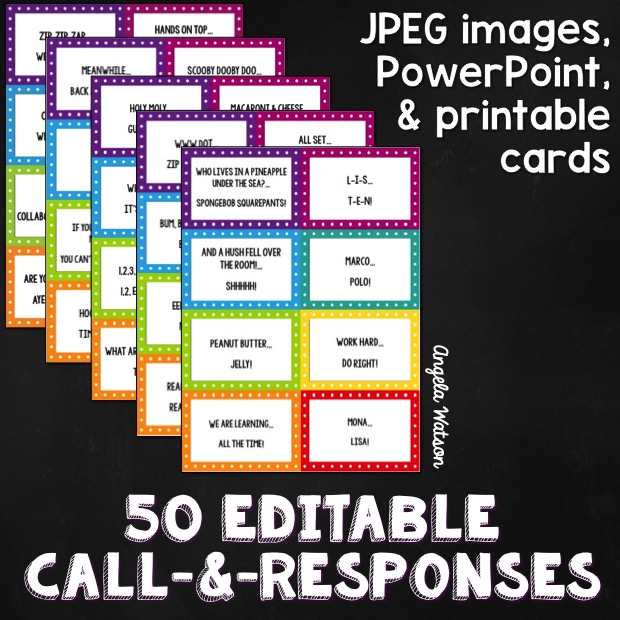At this point in the school year, many of us have lost of the patience and enthusiasm for refocusing kids in a playful way and fallen into the trap of just barking at the kids (“No talking!”) or pleading with them (“I need quiet! Waiting for quiet!”) all day long.
But ironically, it’s more tiring to keep repeating your request for silence, since nagging kids put us in a bad mood and after the hundredth time, the kids just tune us out, anyway. You really are better off trying to muster just a little more energy and grabbing kids attention in a fun and engaging way, because you won’t have to repeat yourself later and you won’t be derailing the positive momentum of your lesson by fussing at off-task students. So, here are 5 types of attention grabbers that I really love using with kids.

1. Music and songs
Music is one of the most fun and effective ways to get students to stop what they’re doing. For the youngest students, use finger plays like the Itsy Bitsy Spider and Open, Shut Them.
But students of any age will respond to simple tunes and musical call-backs, such as “Bum, bada bum bum…Bum, bum!” The great thing about this is that if the kids are singing, then they aren’t talking, and if you make up motions for the song, then their hands are busy, too, so you can be sure they’re not still working or playing with the materials. You can repeat the song or fingerplay or callback if everyone’s not quiet but teach kids that the goal is not to sing it more than once.
If you’re not comfortable singing with your class, try playing music on your computer or phone or CD player. You can use kids’ songs, popular music, classical or jazz songs you want to expose the kids to, or try songs related to your unit of study. I like to use clips of shorter songs — just thirty to sixty seconds. One teacher I know uses a wind-up music box.
Use the same song daily for several weeks, and teach kids that when the music stops, instruction begins. If you use the same song for the same type of transition, kids will have an almost Pavlovian response to it: just hearing the first few notes will immediately trigger the target behavior and get them ready to listen.
2) Instruments and special sounds
Kids hear our voices all day long and the constant buzz of students working together and collaborating becomes background noise for them to tune out. What you need is a distinct sound that breaks through all the other noise in the classroom.
I have become a collector of noisemakers because the variety helps maintain novelty. If kids hear the same sound every 10 or 15 minutes, it’s going to become less effective. So try different things: you can use bells, wind chimes, buddha bowls, triangles, rattles, rainsticks, harmonicas or train whistles…there’s really an endless set of options.
You could dedicate one sound maker or instrument to each transition. For example, the rainstick might always be used to signal that it’s time to finish independent reading or writing time. I love rainsticks for this purpose because their sound is gentle and prolonged and doesn’t jar students out of deep thought or a relaxing time they’ve spent with a book. If kids are particularly engrossed in the activity, you can turn the rainstick upside down and sound it again a second time a bit more quickly while giving a verbal reinforcement.
I like train whistles to signal when it’s time to clean up from an activity because they’re loud enough to rise above all the other sounds in the classroom. For transitions between centers or stations, I like wind chimes because the sound they produce is lengthy and that helps ensure all students hear it even if they’re in the middle of a conversation.
One of my favorite special sounds is a zen chime. I got mine on Amazon for about $8. Zen chimes have a really long sustain. Teach your students to listen quietly to the chime and raise their hands when they hear it stop ringing. This becomes like a game: students will strain to hear it and no one wants to be the first to raise their hand. Within two seconds, it will be so silent in the classroom that you can hear a pin drop.
3) Interactive chants and call-and-responses
All call-and-responses are naturally interactive, but I’ve found that the ones include some kind of physical movement are especially effective.
You can clap out a rhythm for kids to repeat back. Or, use a chant that has motions, like Drop It, Zip It, Lock It, followed by two claps. When you say drop it, the kids have to actually drop what’s in their hands, when you say zip it, that means mouths are closed, and when you say lock it, that means all eyes are locked on the teacher. Then have the whole class all clap twice together. Younger students will say the chant along with you and that’s good, too.
A simpler method is to have a code word that signals students should stop what they’re doing and complete a specific motion. Say jazz hands and have all the kids do that motion. Or say a silly word like banana bread and when students hear it, they grab their ears with the opposite hand crossed in front of them. This causes them to focus on doing something else other than what they were doing and keeps their hands busy.
Try to change up the word and the motion once every few weeks — not too often, because you want them to remember it and respond automatically without thinking — but do change it often enough that kids don’t get sick of it. Let them brainstorm ideas for the code word and motion, and you’ll get even more buy-in.
For more ideas, check out my blog post 50 fun call and response ideas to get students’ attention, or purchase a set that’s fully customizable and ready to use.
4) Visual signals
This is a fun opportunity to get creative. One teacher I know has a wand that she attached a big check mark at the top of (printed from the computer). She then trimmed the check mark in red sparkly garland. She teaches the kids on the first day of school that when she holds the wand up, that they are to ‘check in’. Whenever the class gets off-task, she holds the wand in the air, and the students who are paying attention hold one finger up in the air as a check-in and get quiet until the other kids notice. This works surprisingly well for her, and she never has to say a thing.

I used to use a Time Tracker stoplight that I got from Amazon (similar options here and here). It had 3 colors that would light up, and you could program it so that each color stayed lit for a specific amount of time. So for a 20-minute activity, I’d have it stay on green for 15 minutes, then yellow when there were 5 minutes left, and then red when there was one minute left. When time was up, it would flash red a few times and play an alert sound.
I had many students who LOVED that timer and requested that I use it for almost every activity. They loved being able to estimate and manage their time, and they’d get all excited when it changed (It’s on yellow guys, come one, we’ve got to finish up!). The rest of the class would hear this and it would alert them to the time without me having to say a word. It was a terrific investment, so I highly recommend visual time trackers.
5) Interactive countdowns
This could be as simple as saying 3,2,1 hands up. Or you could hold up your hand and use your fingers to show the numbers as you say, Teaching in 5, teaching in 4, teaching in 3, all the way down to 1. If you teach elementary grades, have students to show the number on their fingers and participate in the countdown with you. With practice over time, you won’t even need to say anything: you can just put your hand up and countdown on your fingers.
I usually use a very straightforward backward countdown, if the class is quiet enough to hear me make the announcement. I’ll say, When I get to zero, I need the room to be completely quiet. 10, 9, 8… When time is up, I move on to the next activity just like I said I’d do, and let stragglers catch up without acknowledging them except to help as needed. I’ve found that if you’re consistent with this, students will learn you mean what you say and they have to keep pace!
Attention grabbers don’t have to be an annoyance for you. Think of them as a way to be creative and have fun with your students. Most of us desperately need more fun in our school day. Involve the kids in thinking of new ways to bring the group together as a class, and change up techniques to keep things fresh.
Each day of our lives, we make deposits in the memory banks of our children. --Charles Swindoll. Click To TweetIt’s not fun to nag kids and repeat ourselves, and it’s not fun for them to be nagged or lectured. Let’s make classroom memories that are playful and positive and enjoyable. Refocusing a class is something we have to do dozens of times per day: why not create routines for that which are enjoyable and engaging?
Want to listen instead of read?
Listen to season 2 episode 14 below,
or subscribe in your podcast app.
This post is based on the latest episode of my weekly podcast, Angela Watson’s Truth for Teachers. A podcast is like a free talk radio show you can listen to online, or download and take with you wherever you go. I release a new 10-15 minute episode each Sunday and feature it here on the blog to help you get energized and motivated for the week ahead. I’d love to hear your thoughts below in the comment section!
![]() See blog posts/transcripts for all episodes
See blog posts/transcripts for all episodes
The Truth for Teachers Podcast
Our weekly audio podcast is one of the top K-12 broadcasts in the world, featuring our writers collective and tons of practical, energizing ideas. Support our work by subscribing in your favorite podcast app–everything is free!
Explore all podcast episodes
Angela Watson
Founder and Writer
Sign up to get new Truth for Teachers articles in your inbox
Discussion
Leave a Reply
OR

Join our
community
of educators
If you are a teacher who is interested in contributing to the Truth for Teachers website, please click here for more information.




















I like these ideas for getting students’ attention especially the use of different noise makers. The check-in idea is one I will definitely use, especially for the more visual students.
I’m so glad the post was helpful! Thanks for sharing.
Hello Angela,
I just want to thank you for creating your podcasts. They have really helped me continue my passion of learning and helping understand how to be the best mathematics teacher of geometry.
Thank you!
Maddie
I appreciate your kind words so much, Maddie!
Thanks ma’am. Sharing you further to young teachers.
Hi Angela,
I discovered your podcast over our Summer here in Australia. I’m a pre-service teacher in my second year at the University of Melbourne. I also want to join the chorus of your praise, as some of your segments are the perfect tonic of encouragement one needs after days in the classroom. As a pre-service teacher, and I imagine as a replacement teacher, you enter an already established environment, and it is difficult to find and negotiate your own teaching identity. I recall an episode where you spoke about making comparisons to other teachers and the caution one should take when doing so. I think you said you were channeling your own mentor when it did not fit with who you were. So it’s great to know that we’re not alone. Anyway, I’ve found your words to be encouraging, reassuring and uplifting. You’re a great digital mentor to have while studying. Thank you for sharing your wisdom.
Hi, Brenton! Thank you so much for the kind words. I believe this is the episode you’re thinking of. I certainly did get burned by blindly emulating others! So honored to be a part of your development as a teacher and to help avoid making some of the mistakes I have. 🙂